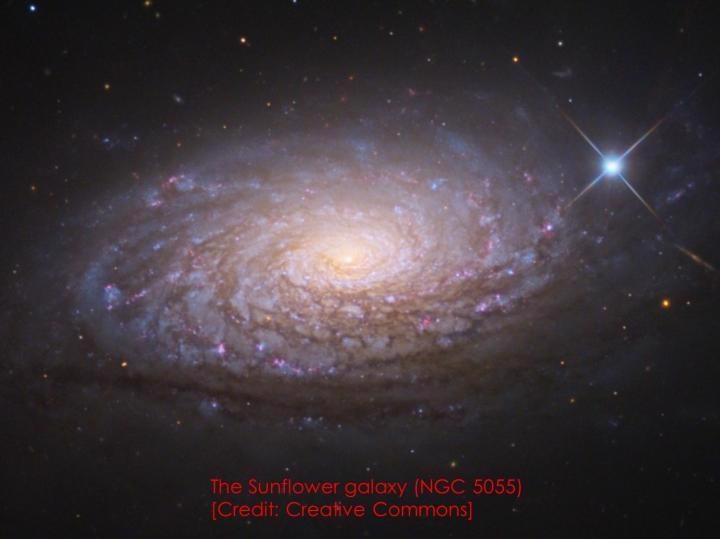Dec 17 2020
An international research team has recently published a study challenging that a rival concept to the well-known hypothesis of dark matter can more precisely estimate a galactic phenomenon that seems to defy the traditional rules of gravity. The study also included Stacy McGaugh, Astronomy Chair at Case Western Reserve University.
 The best example is represented by the Sunflower galaxy (NGC 5055) with the strongest external field among SPARC galaxies, whose well-measured rotation curve shows a mildly declining behavior at a large radial distance and can be accurately modeled only with an external field effect. Image Credit: Creative Commons.
The best example is represented by the Sunflower galaxy (NGC 5055) with the strongest external field among SPARC galaxies, whose well-measured rotation curve shows a mildly declining behavior at a large radial distance and can be accurately modeled only with an external field effect. Image Credit: Creative Commons.
According to the astrophysicists, this is a major finding because it additionally establishes the hypothesis, known as modified Newtonian dynamics (MOND) or 'modified gravity,' as a feasible explanation for a cosmological predicament—that is, galaxies seem to buck the long-established rules of gravity that were traced back to Sir Isaac Newton in the late 1600s.
The predicament is that for many years scientists have quantified more gravitational pull in space than their expectations and that sufficient known or visible matter is not available to consider it all.
Therefore, the proponents of dark matter have theorized that a majority of the familiar universe is, in fact, composed of a material that never interacts with light, rendering it undetectable and invisible, but they have also proposed that this material is responsible for most of the gravitational pull among the galaxies. For almost five decades, this has been the prevailing concept.
According to MOND theory, a counter elucidation made by Mordehai Milgrom, a physicist from Weizmann Institute (Israel) in the early 1980s, this gravitational pull is present because the rules of gravity are somewhat changed.
Rather than attributing the surplus gravitational pull to an undetectable, invisible dark matter, the MOND theory has proposed that low gravitational accelerations are more powerful than would be estimated by a pure Newtonian understanding.
The MOND theory has also made a bold prediction—the internal movements of an object in space should both rely on the mass of the object itself and the gravitational pull from all other masses present in the universe, known as 'the external field effect' (EFE).
According to Milgrom, if these findings are strongly established, they would be “the smoking gun proving that galaxies are governed by modified dynamics rather than obeying the laws of Newton and of general relativity.”
150 Galaxies Tested for EFE
According to McGaugh and his colleagues, headed by Kyu-Hyun Chae from Sejong University in South Korea, they spotted this EFE in over 150 galaxies examined to date. The researchers’ findings were recently published in The Astrophysical Journal.
The external field effect is a unique signature of MOND that does not occur in Newton-Einstein gravity. This has no analogy in conventional theory with dark matter. Detection of this effect is a real head-scratcher.
Stacy McGaugh, Astronomy Chair, Case Western Reserve University
The group, comprising six astronomers and astrophysicists, includes the lead author of the study Chae and other contributors from Italy, the United Kingdom, and the United States.
I have been working under the hypothesis that dark matter exists, so this result really surprised me. Initially, I was reluctant to interpret our own results in favor of MOND. But now I cannot deny the fact that the results as they stand clearly support MOND rather than the dark matter hypothesis.
Kyu-Hyun Chae, Study Lead Author, Sejong University
Analyzing Rotating Galaxies
As part of their analysis, the researchers examined a total of 153 rotation curves of disk galaxies. The galaxies were chosen from the Spitzer Photometry and Accurate Rotation Curves (SPARC) database, which was developed by another colleague, Federico Lelli, while he was doing his postdoctoral studies at Case Western Reserve University, and by McGaugh and the co-author of the study, James Schombert, from the University of Oregon.
Apart from Chae, McGaugh, Lelli, and Schombert, the authors of the study were Pengfei Li from Case Western Reserve University and Harry Desmond from the University of Oxford.
According to the researchers, they decoded the EFE by observing that galaxies in powerful external fields slowed (or displayed decreasing rotation curves) more often when compared to galaxies in weaker external fields, as estimated by MOND theory alone.
Lelli added that initially, he was skeptical by the outcomes “because the external field effect on rotation curves is expected to be very tiny. We spent months checking various systematics. In the end, it became clear we had a real, solid detection.”
McGaugh added that skepticism is part of the scientific process and is aware of the reluctance of several investigators to contemplate MOND as a possibility.
I came from the same place as those in dark matter community. It hurts to think that we could be so wrong. But Milgrom predicted this over 30 years ago with MOND. No other theory anticipated the observed behavior.
Stacy McGaugh, Astronomy Chair, Case Western Reserve University Astronomy
Journal Reference:
Chae, K.-H., et al. (2020) Testing the Strong Equivalence Principle: Detection of the External Field Effect in Rotationally Supported Galaxies. The Astrophysical Journal. doi.org/10.3847/1538-4357/abbb96.